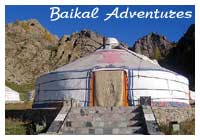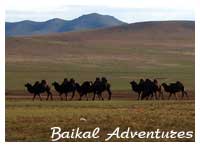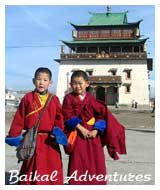|
|
Mongolia.
 Mongolia
- The Mongolian Republic is a country located in the center of Asia. It
borders on Russia to the North, and on China to the East, South and West.
Mongolia is one of the oldest states in the world. It is the seventh largest
country in Asia, covering a territory of 1,565,000 sq. km, and one of
the largest land-locked countries in the world. The territory of Mongolia
stretches along 2392 km from the Altai Mountains in the West to the East,
and along 1259 km from the Sayan Mountain Ranges in the North to the Gobi
Desert in the South. Ulan-Bator (with 870,000 inhabitants) is the capital
of Mongolia and home to around one third of the country’s population.
Mongolia is a parliamentary republic with the president as the head of
the state. The country is divided into 18 administrative provinces (aymak)
and 3 municipal entities (hotuud). Mongolia
- The Mongolian Republic is a country located in the center of Asia. It
borders on Russia to the North, and on China to the East, South and West.
Mongolia is one of the oldest states in the world. It is the seventh largest
country in Asia, covering a territory of 1,565,000 sq. km, and one of
the largest land-locked countries in the world. The territory of Mongolia
stretches along 2392 km from the Altai Mountains in the West to the East,
and along 1259 km from the Sayan Mountain Ranges in the North to the Gobi
Desert in the South. Ulan-Bator (with 870,000 inhabitants) is the capital
of Mongolia and home to around one third of the country’s population.
Mongolia is a parliamentary republic with the president as the head of
the state. The country is divided into 18 administrative provinces (aymak)
and 3 municipal entities (hotuud).
 Lifestyle.
The Mongols are shy by nature. They often hide their confusion or embarrassment
behind a smile. Most Mongols are taciturn, reticent, tolerant, and some
people say, superstitious. Fussiness and inconsistency are considered
undignified. At the same time, the Mongols may get very excited while
playing a game, or just boil over in anger. The Mongols do not like to
talk about unpleasant things. It is believed that such talk may invoke
only more trouble. It is also forbidden to say bad things about relatives
and friends. When from time to time something unpleasant has to be said,
people try to do it as tactfully and inoffensively as possible. Lifestyle.
The Mongols are shy by nature. They often hide their confusion or embarrassment
behind a smile. Most Mongols are taciturn, reticent, tolerant, and some
people say, superstitious. Fussiness and inconsistency are considered
undignified. At the same time, the Mongols may get very excited while
playing a game, or just boil over in anger. The Mongols do not like to
talk about unpleasant things. It is believed that such talk may invoke
only more trouble. It is also forbidden to say bad things about relatives
and friends. When from time to time something unpleasant has to be said,
people try to do it as tactfully and inoffensively as possible.
On the other hand, expressions of goodwill and praise are widespread.
Praise of their mother, their country, the beauty of the natural scenery,
or a host’s hospitality, represents a special form of Mongolian
folklore. Foreign guests will very quickly recognize Mongolian friendliness
and hospitality. The hard conditions for life have not embittered them
but instead encouraged a long-standing tradition of mutual support and
hospitality. The host very well knows that the traveler entering his yurt
(ger) is certainly tired and still may have a long way to go. Because
he himself has also experienced a similar situation several times while
traveling, he does his best to anticipate and satisfy his guest's wishes.
Such specific features such as Mongolia's vast, sparsely populated area,
its rigorous climate and nomadic livelihood system considerably influenced
people's behavior and the way they express their thoughts and feelings.
Over the centuries these nomadic people have developed their own ethics
of social interaction. In the cities a foreigner may safely behave like
elsewhere in the world. On the contrary in the countryside at every step
he will stumble against all kinds of customs and traditions, violating
them without even recognizing it. This is especially true for remote regions
where traditions and customs are more intensively conducted. However,
the Mongols are not offended if foreigners behave inadequately because
of their unawareness. "The ignorant will not be punished," as
the Mongols say.
 Harahorum
(Hara Horin), the capital of the Old Mongolian State, was founded
in 1220 by Genghis Khan and existed until the 16th century. The ruins
of Harahorum are situated in the upstream area of the River Orkhon. Historical
recordings of Harahorum are found in Chinese annals and in notes of European
travelers of the 13th century such as Plano Carpini, Marco Polo, or V.
Rubruka. Harahorum
(Hara Horin), the capital of the Old Mongolian State, was founded
in 1220 by Genghis Khan and existed until the 16th century. The ruins
of Harahorum are situated in the upstream area of the River Orkhon. Historical
recordings of Harahorum are found in Chinese annals and in notes of European
travelers of the 13th century such as Plano Carpini, Marco Polo, or V.
Rubruka.
At
the end of the 19th century the Russian researcher N.M. Jadrintsev investigated
the ruins of Harahorum. A.M. Pozdneev, analyzing historical sources, has
confirmed the location of Harahorum nearby the Buddhist monastery Erdenidzu
(built in 1585 in the southern part of Harahorum). During the Soviet-Mongolian
Expedition in 1948-1949, guided by S.V. Kiselyov, parts of Harahorum were
excavated.
The ruins of the Ugedey Palace, situated on a granite pedestal, have been
discovered in the southwestern part of the city. Under the palace, the
remains of a Buddhist Kumirny with wall paintings from the end of the
12th to the beginning of the 13th centuries have been found. In the central
section of the city, trading and crafts quarters as well as other objects
have been revealed.
The
Erdenizu Monastery - The first Buddhist Monastery of Mongolia,
“Erdenizu”, surrounded by a monumental 400m-long wall with
108 Stupas, is located on the ruins of the old city of Harahorum. In the
year 1792, this place was home to 62 temples and 10,000 Lamas. Later,
some parts of the monastery were destroyed. However, since 1990 it has
been in operation , and a large part of its former beauty has been restored.
The three temples located inside the wall represent the three stages of
Buddha’s life: as a child, as an adolescent, and as an adult. In
the main temple, called Buddha’s treasure, you can find the child
statue of Buddha. Formerly, four rocky turtles surrounded the Old City
of Harahorum, of which only two have been conserved to this day.
Terelj National Park.
The Gorkhi Terelj National Park is situated 60 km from
Ulan Bator. The natural scenery of Terelj is one of the most impressive
ones in Mongolia. The National Park lies on the edge of the Khengeisky
Mountain Ridge with unique mountain and steppe landscapes. Terelj, formerly
a part of the Han-Henteisky Nature Reserve, was established as a National
Park in 1995.
The road ends at the Terelj village, the last permanent settlement in
this region. From there on you will find few sign of human life –
only a few nomadic families with their herds can be spotted every now
and then. It is a quiet and peaceful landscape where you can enjoy the
wild and pristine beauty of nature; the interesting formations of granite
rocks, primeval forest, big rivers and a great number of wild flowers.
Terelj is famous for its impressive mountain rocks – fantastical
formations of weathered granite. The rock Melhiy-Hal in the shape of a
giant turtle has become the symbol of Terelj. It is a popular place for
the annual ceremony of the Mini-Naadam holiday.
There are many mountain rocks that amaze tourists with their exotic forms
– such as a hare, a sleeping dinosaur, or a person reading in a
book on his knees.
Within the magnificent area of the Terelj Valley, you can find several
tourist camps and summer camps for children. Moreover, here you will have
the opportunity for horseback and camel riding.
tour
programme
Let's
go!
| |
